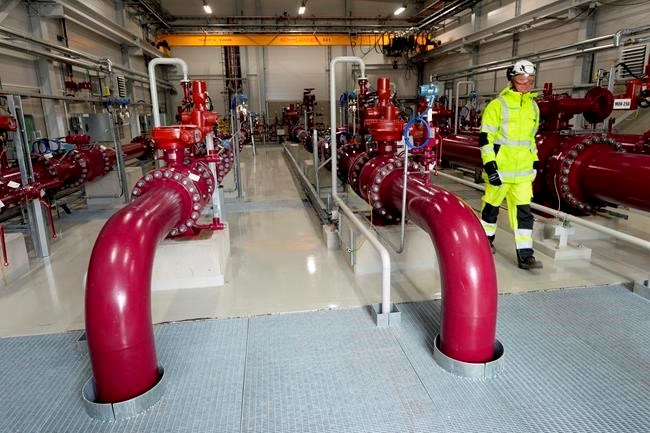HELSINKI (AP) — Damage to an undersea gas pipeline and telecommunications cable connecting Finland and Estonia appears to have been caused by “external activity," Finnish officials said Tuesday, adding that authorities were investigating.
Finnish and Estonian gas system operators on Sunday said they noted an unusual drop in pressure in the Balticconnector pipeline after which they shut down the gas flow.
The Finnish government on Tuesday said there was damage both to the gas pipeline and to a telecommunications cable between the two NATO countries.
Speaking at a news conference Tuesday, Prime Minister Petteri Orpo stopped short of calling the pipeline leak sabotage but said it could not have been caused by regular operations.
“According to a preliminary assessment, the observed damage could not have occurred as a result of normal use of the pipe or pressure fluctuations. It is likely that the damage is the result of external activity," Orpo said.
Finland's National Bureau of Investigation was leading an inquiry into the leak, Orpo said, adding that the leak occurred in Finland's economic zone. According to Estonian authorities, the damaged area of the data cable owned by the Finnish mobile operator and Internet service provider Elisa is likely located in Estonia's economic zone, and Estonia's military was investigating the matter.
In the Estonian capital, Tallinn, Defense Minister Hanno Pevkur told reporters Estonian authorities received photos confirming that the damage in the Balticconnector is “mechanical" and “human-made.”
“This damage must have been caused by some force that was not created by ... a diver or a small underwater robot; the damage is more massive,” Pevkur said, adding that seismologists have previously stated there was no explosion at the incident site.
Heidi Soosalu, seismologist at the Estonian Geological Service, told the Estonian public broadcaster ERR on Tuesday that neither Estonian nor Finnish seismic stations registered anything resembling explosions during the time period the Balticconnector developed a suspected leak.
The incident comes just over a year after the Nord Stream gas pipelines running between Germany and Russia in the Baltic Sea were damaged by explosions believed to be sabotage. The case remains unsolved.
“Finland is well prepared," Orpo said. "Protecting critical infrastructure is already a very important issue with the change in the security environment, and attention has been paid to it. In the background, among other things, a wide network of actors has been built to secure critical infrastructure.”
Asked by a reporter whether the government suspected Russian involvement in the latest incident, Orpo said he didn’t want to speculate on potential perpetrators before authorities completed the investigation in Finland.
Earlier, Finnish Sauli Niinistö said in a statement that the “damage to the underwater infrastructure has been taken seriously and the causes have been under investigation since Sunday.” He said he was in contact with allies and partners, including NATO Secretary-General Jens Stoltenberg.
Stoltenberg wrote on X, formerly known as Twitter, that he had spoken with Niinistö ”on damage to undersea infrastructure." He said NATO is sharing information and "stands ready to support Allies concerned.”
The pipeline incident was likely to be put on the agenda for a NATO defense ministers meeting in Brussels on Wednesday and Thursday.
Estonia’s Navy told The Associated Press that they were conducting an investigation on the pipeline together with the Finnish military in the Gulf of Finland. They wouldn’t comment further, saying the operation was led by the Finns.
The 77-kilometer-long (48-mile-long) Balticconnector pipeline runs across the Gulf of Finland from the Finnish city of Inkoo to the Estonian port of Paldiski. It is bi-directional, transferring natural gas between Finland and Estonia depending on demand and supply. Most of the gas that was flowing in the pipeline early Sunday before closure was going from Finland to Estonia, from where it was forwarded to Latvia, Estonia’s gas system operator Elering said.
The 300 million euro ($318 million) pipeline, largely financed by the European Union, started commercial operations at the beginning of 2020.
Gasgrid Finland said the Finnish gas system is stable and the supply of gas has been secured through the offshore support vessel Exemplar — a floating liquefied natural gas terminal at the southern Finnish port of Inkoo.
Elering said Estonian consumers were receiving gas from Latvia after the shutdown of the pipeline.
While Europe currently has filled 97% of its gas storage capacity for the winter, security of supply still depends on deliveries of pipeline gas and LNG.
“When it comes to gas, Europe is in for a safe winter,” said Simone Tagliapietra, energy analyst at the Bruegel think tank in Brussels. “However this depends on the integrity of its pipeline and LNG infrastructure. Sabotage or disruptions could have severe consequences. Developments at the Balticconnector in Finland are very concerning with this regard."
Natural gas prices on Europe’s TTF benchmark rose 15% on Monday and more than 12% on Tuesday to the highest level since March. But Tuesday’s price of 49.40 euros ($52.44) per megawatt hour is still seven times lower than record highs seen in late August after Russia’s cutoff of most gas supplies to Europe during the war in Ukraine spurred an energy crisis.
___ Associated Press writer Jan M. Olsen in Copenhagen, Denmark, Lorne Cook in Brussels, David McHugh in Frankfurt, Germany and Courtney Bonnell in London contributed to this report.
Jari Tanner, The Associated Press


